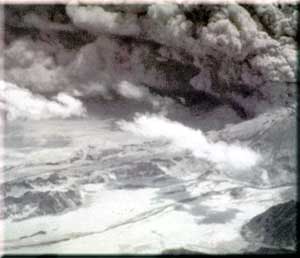Volcanic Eruption
Mount Pinatubo
June 15, 1991
The eruption of Mount Pinatubo in the Philippines on June 15, 1991, was one of the largest volcanic
eruptions in the 20th century. It could have killed or injured tens of thousands of people, but fortunately the
eruption injured fewer than 500. About 1 million people, including some 20,000 American military
personnel and their families at two U.S. military bases, lived near the volcano. Because volcanologists with
the Philippine Institute of Volcanology and Seismology and the U.S. Geological Survey (USGS) forecasted
the eruption, civil and military leaders were able to evacuate people in time, saving thousands of lives.
John Ewert was among the 23 USGS scientists and electronics and computer specialists on the joint
Philippine-American team. One of Ewert's responsibilities was to install telemetered tiltmeters on the
volcano. These instruments transmitted data to the scientists headquartered at Clark Air Force Base so that
they could monitor changes in the volcano's shape. Ewert explained that as magma rises in a volcano, it
changes, or deforms, the volcano's shape.
When asked what type of scientist he is, Ewert responded, "I guess I am a geologist. No, I guess I am a
volcanologist." He further explained that volcanology is "highly interdisciplinary." It includes geochemistry,
stratigraphy (layers of rocks), geophysics, and the subdisciplines of geophysics such as seismology
(movements in the Earth's crust). "And there are lots of things we do that require a facility with electronics
— from knowing how to solder two wires together to troubleshooting circuitry."
Ewert has an undergraduate degree in geology and has completed 2 years of graduate study.
"Experience," he explains, "is kind of how I got into what I am doing. I finished my undergraduate degree in
1980 when Mount St. Helens erupted, and I was hired several months later. Over a period of 4 years I did
everything from airborne gas monitoring, to deformation studies of the volcano's crater, to hydrologic
monitoring of the streams around the volcano. There is really no substitute for that kind of experience. You
don't go to a university and major in erupting volcanoes."
Rick Hoblitt, another member of the team, was an organic chemist before he earned a doctorate in
geology. As part of the team at Mount Pinatubo, Hoblitt examined and mapped deposits left by past eruptions
to anticipate what types of eruptions were likely to happen and the areas that were likely to be affected.
"Really what I see as my chief role in these crises is data synthesis, interpretation, and then communication of
that synthesis."
With the information they collected, Rick Hoblitt, John Ewert, and other scientists were responsible for
predicting if a catastrophic eruption would occur and when an evacuation should be ordered. The stress was
intense. More than 10 days before the major eruption, Hoblitt wrote in his diary, "Activity at vent is up. More
ash is coming up, some puffs to 1,000 feet above the summit. Dave, Andy, John, and I discuss the situation
after breakfast. We're not sleeping well because of nerves. Is it possible that a catastrophic eruption could
occur with no warning? I think that this is possible. Depressing subject." Hoblitt was afraid that they wouldn't
be able to forecast an eruption in time to save lives. Fortunately their timing was correct.
More information on natural hazards is on the USGS Web site at
www.usgs.gov/hazards.
|

Mount Pinatubo after its major eruption on June 15, 1991

Plume from a smaller eruption, July 1991.
|


